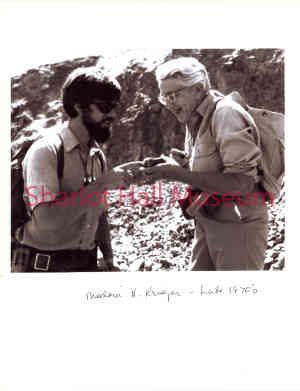By Katherine Krieger Pessin
Medora had finally achieved her longtime goal of becoming a field geologist with the USGS and was assigned to Prescott, Ariz., in 1947. She spent the next 35 years mapping in the State of Arizona, a total of 12 quadrangles, including those of Prescott and Paulden. She has to her credit many professional papers for publication with the USGS as well as other scientific organizations.
 In order to record the physical history and structure of the earth on a map, one has to determine the kinds of rocks and minerals in an area, follow out contacts, determine the age of formations, locate faults (the folding and lifting of large parts of the earth's crust), find where there have been ancient seas or oceans, examine erosion processes and, finally, put it all down on a map. This map may be different from maps as most people know them, but to a geologist they tell the story of the earth. From these maps, soil composition, potential mineral deposits and water resources can be determined.
In order to record the physical history and structure of the earth on a map, one has to determine the kinds of rocks and minerals in an area, follow out contacts, determine the age of formations, locate faults (the folding and lifting of large parts of the earth's crust), find where there have been ancient seas or oceans, examine erosion processes and, finally, put it all down on a map. This map may be different from maps as most people know them, but to a geologist they tell the story of the earth. From these maps, soil composition, potential mineral deposits and water resources can be determined.
By 1947, there were other women who wanted to do field work, but were up against the Survey's policy of not allowing women to do field work. Men who did field work were routinely assigned other male assistants. When Medora began to ask for assistants, the Survey had no trouble finding women who wanted to get field experience. In fact, they sought her out. Medora's male colleagues called this group "Medora's School for Girls." Medora was told to work them so hard that they would be willing to stay in Washington, D.C. She did work them hard, but no harder than she herself worked. Field days usually began at 7 a.m. and ended hopefully by 5 p.m. Saturday mornings were spent in the office labeling specimens, bringing the map up to date and writing up notes.
Equipment used in those days consisted of a web belt on which were carried a Brunton compass, altimeter, alidade, notebook, pencils, pen, scales and two canteens of water. A knapsack contained lunch, another canteen of water and sacks for specimens. Also carried were a pocket stereoscope, a hand lens and a hammer. In addition to this was a tripod with a 15-inch plane table board. On the board was mounted part of a 7 1/2 minute topographic map. The purpose of the plane table mounted map was to locate oneself accurately. After leveling the board and orienting it accurately, the alidade was used to sight on three known points. Lines drawn from these points intersected at one's exact location. Aerial photos could be examined with a pocket stereoscope.
 Medora was not only a field mapper. She went on to make major contributions to the geology of the southwestern United States. Perhaps her greatest achievement was in the publication of USGS Professional Paper 1008: "Large landslides, composed of megabreccia, interbedded in Miocene deposits, Southeastern Arizona" (1977). She also solved many puzzles within Arizona geology. For example, she worked out difficult relationships between the Precambrian and Cambrian rocks of Arizona. This was a direct result of her meticulous mapping in central Arizona.
Medora was not only a field mapper. She went on to make major contributions to the geology of the southwestern United States. Perhaps her greatest achievement was in the publication of USGS Professional Paper 1008: "Large landslides, composed of megabreccia, interbedded in Miocene deposits, Southeastern Arizona" (1977). She also solved many puzzles within Arizona geology. For example, she worked out difficult relationships between the Precambrian and Cambrian rocks of Arizona. This was a direct result of her meticulous mapping in central Arizona.
Medora Krieger died at age 89 in 1994 in Prescott. She was active as long as her health permitted. She was hiking in the Andes Mountains of Peru at elevations of 10,000 feet in 1982 at age 78. She is well-known within the Arizona geological community, but deserves to be recognized nationwide for her overall contributions to the profession and for her groundbreaking work in opening opportunities for women in geology.
If you Google "Medora Krieger" you will find many references to her work, including scientific papers and accomplishments, including her 1965 professional paper, "The Geology of the Prescott and Paulden Quadrangles." At http://pubs.usgs.gov/circ/c1050/index.htm is an extensive history of the many-faceted USGS from its inception by an act of Congress in 1879 to "classify public lands, examine geologic structure, mineral resources and products of the national domain." It is interesting to note that the second director of the USGS (from 1881-1894) was John Wesley Powell, well-known for his Grand Canyon explorations in 1869 and 1871. Today the 10,000 scientists, technicians and support staff of the USGS are working in more than 400 locations throughout the United States.
The author of this article, Medora's daughter Katherine Pessin, lives in Prescott.
This and other Days Past articles are available on sharlothallmuseum.org/archives and via RSS e-mail subscription.


